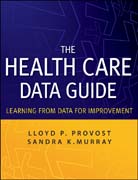
The health care data guide: learning from data for improvement
Provost, Lloyd P.
Murray, Sandra
Step by step this comprehensive resource explores the statistical process control (SPC), a philosophy, a strategy, and a set of methods for ongoing improvement of processes and systems to yield better outcomes in health care organizations. It includes information on processes, stratification, rational subgrouping and stability and capability analysis, measurement, data collection methods, planned experimentation, and graphical methods. This book shows how to apply SPC to evaluate current process performance, search for ideas for improvement, tell if changes have resulted in evidence of improvement, and track implementation efforts to document sustainability of the improvement.List of Figures, Tables, and Exhibits. Preface. Who Is This Book For? Why AreWe Writing This Book? What Is the Book About? How Is the Book Organized? Acknowledgments. Part I Using Data for Improvement. 1 Improvement Methodology. Fundamental Questions for Improvement: The Model for Improvement. What Are We Trying to Accomplish? How Will We Know That a Change Is an Improvement? What Changes Can We Make That Will Result in Improvement? The PDSA Cycle for Improvement. Tools and Methods to Support the Model for Improvement. Designing PDSA TestCycles. Analysis of Data from PDSA Cycles. Case Study: Improving Care of Diabetic Patients. 2 Obtaining Data for Improvement. What does the Concept of DataMean? How Are Data Used? Types of Data. The Importance of Operational Definitions. Form for Developing Improvement Project Measures. Data for Different Types of Studies. Use of Sampling. What About Sample Size? Appropriate Scope for a PDSA Cycle. Stratification of Data. What About Risk or Case-Mix Adjustment? Transforming Data. Analysis and Presentation of Data. Using a Family of Measures. 3 Understanding Variation Using Run Charts. What Is a Run Chart? Use of a Run Chart. Constructing a Run Chart. Examples of Run Charts for Improvement Projects. Probability-Based Tests to Aid in Interpreting Run Charts. Special Issues in Using Run Charts. Stratification with Run Charts. The Multi-Vari Run Chart. Using the Cumulative Sum Statistic with Run Charts. 4 Learning From Variation in Data. The Concept of Variation. Depicting Variation. Introduction to Shewhart Charts. Interpretation of a Shewhart Chart. Establishing and Revising Limits for Shewhart Charts. When Do We Revise Limits? Stratification with Shewhart Charts. Rational Subgrouping. Shewhart Charts with Targets, Goals, or Other Specifications. Special Cause: Is It Good or Bad? Other Tools for Learning from Variation. Frequency Plots. Pareto Charts. Scatter Plot. 5 Understanding Variation Using Shewhart Charts. Selecting the Type of Shewhart Chart. Chart Selection Guide. Shewhart Charts for Continuous Data. I Charts. Examples of Shewhart Charts for Individual Measurements. Rational Ordering with an IndividualChart. Effect of the Distribution of the Measurements Example of Individual Chart for Deviations from a Target. X-Bar and S Chart. Shewhart Charts for Attribute Data. Subgroup Size For Attribute Charts. The P Chart for ClassificationData. Examples of P Charts. Creation of Funnel Limits for P chart. C and U Charts for Counts of Nonconformities. C Charts. U Charts. Creation of Funnel Limits for a U chart. Process Capability. Process Capability from an I Chart. Capability of a Process from X-bar and S Chart (or R chart). Capability of a Process from Attribute Control Charts. Capability from a P Chart. Capability from a C or U Chart. Appendix 5.1: Calculating Shewhart Limits. Part II Advanced Theory and Methods with Data. 6 Shewhart Chart Savvy: Dealing with Some Issues. Designing Effective Shewhart Charts.
- ISBN: 978-0-470-90258-5
- Editorial: John Wiley & Sons
- Encuadernacion: Rústica
- Páginas: 400
- Fecha Publicación: 31/08/2011
- Nº Volúmenes: 1
- Idioma: Inglés
